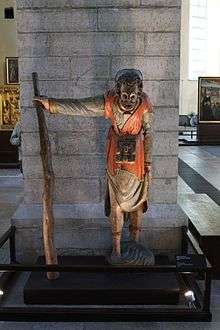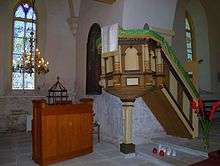Tobias Heinze
Tobias Heinze (c. 1593–1653) (also Heintze) was an Estonian cabinetmaker and woodcarver based in Tallinn.

St Christopher in St. Nicholas' Church, Tallinn
Pulpit in Harju-Risti church

Pulpit in Jõelähtme church
He is best known for his carving of St Christopher which stands in the church of St Nicholas’ in Tallinn. It was carved to support the pulpit. He also made modifications to the Holy Kinship altar which was originally in Tallinn town hall but bought by a rural congregation in 1652.[1][2] This is now also preserved in St Nicholas' Church, Tallinn.
List of works
- St Christopher statue, St. Nicholas' Church, Tallinn, Estonia. 1624
- Pulpit, Holy Cross Church, Harju-Risti, Estonia 1630[3]
- Altar, Keila Church, Central Square, Keila, Estonia 1632[4]
- Pulpit, Keila Church, Central Square, Keila, Estonia 1632[5]
- Pulpit, St Nicholas’ Church, Kose, Estonia
- Pulpit, The Church of the Blessed Virgin Mary, Jõelähtme, Estonia
gollark: =tex 5.\frac{3}{2}
gollark: Hey, you could implement *hashtags*.
gollark: I'm imagining all the evil stuff I could make stuff do.
gollark: You could call it "5.15". Probably shouldn't. But could.
gollark: Add and subtract are some kind of compose, I forgot which way round, and concat is... some kind of arrowy operator? It returns a new function which runs two functions on the same input and returns two outputs.
References
- Kurisoo, Merike. "Netherlandish Altarpieces and Sculptures in the Niguliste Museum". Codart Ezine. Codart. Retrieved 21 June 2016.
- Nömberg, Ebe. "Restaureeritud Brüsseli altar ja Tobias Heinze (1583-1653)". Koduge Teatmik. Eesti NSV Riiklik Kunstimuuseum.
- Andreson, Kristia. "Kolkata-skulptuurid Harju-Risti kirikust" (PDF). Studies on Art and Architecture. Estonian Society of Art Historians. Retrieved 21 June 2016.
- "3588 Altar, T.Heinze, 1632 portreed 1836 (puit, polükroomia, õli, lõuend)". National Register of Cultural Monuments. Estonian National Heritage Board. Retrieved 21 June 2016.
- "3589 Kantsel, T.Heinze, 1632 (puit, polükroomia)". National Register of Cultural Monuments. Estonian National Heritage Board. Retrieved 21 June 2016.
| Wikimedia Commons has media related to Tobias Heinze. |
This article is issued from Wikipedia. The text is licensed under Creative Commons - Attribution - Sharealike. Additional terms may apply for the media files.